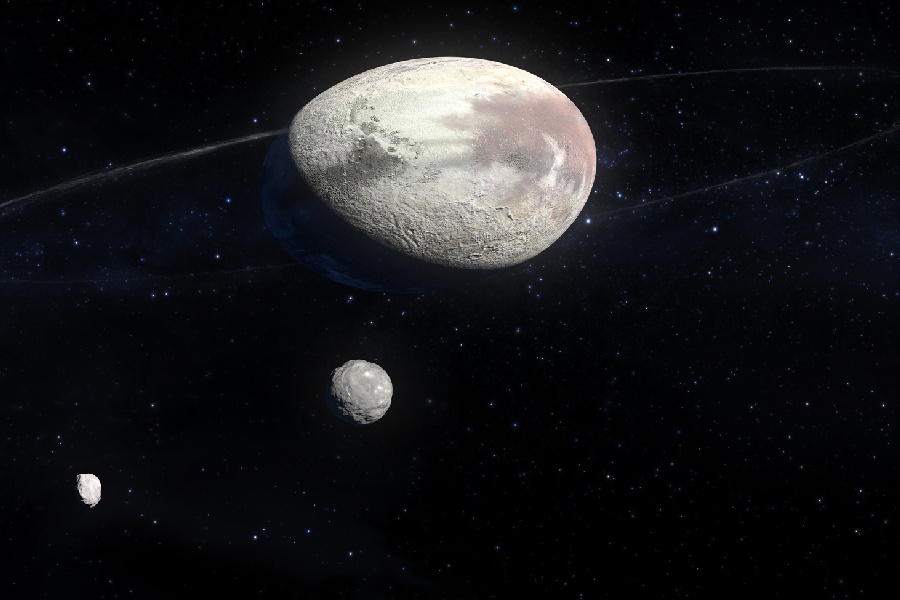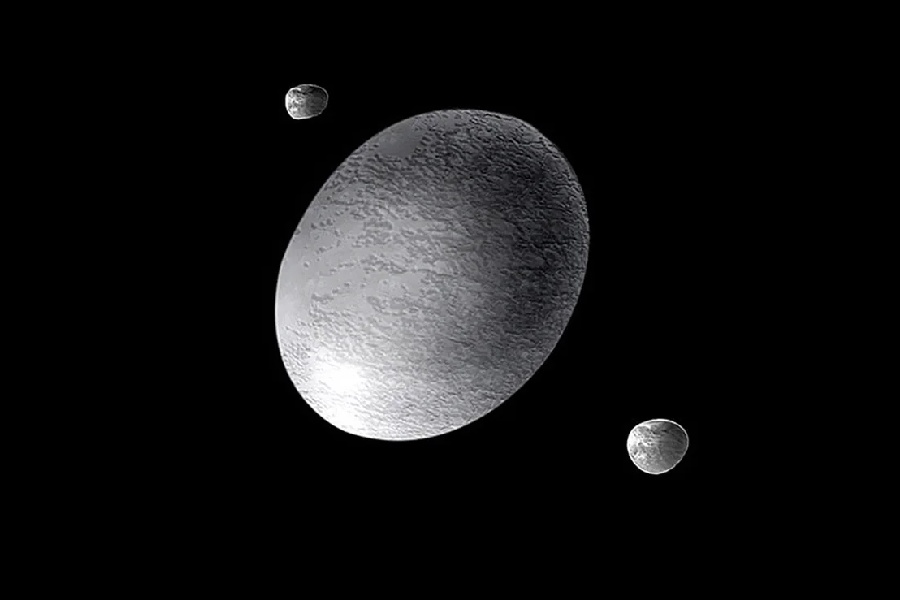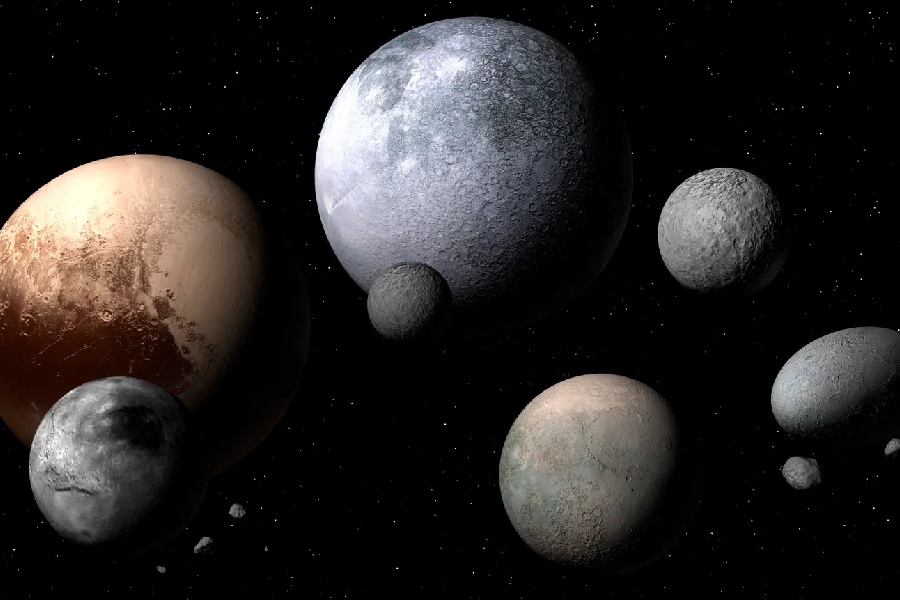Haumea orbits beyond Neptune in a Kuiper Belt region. It is one of the most distant objects humans have sent spacecraft to study directly. But what is Haumea actually? Where is Haumea located? Why is Haumea oval shaped?
In this article, we will unravel the perplexing qualities that make Haumea unique. We will also explore how this weird cosmic body changes ideas about how planets form at the edges of our solar system.
From its dramatic discovery to its two moons and intriguing surface features, Haumea’s odd traits raise as many questions as insights. As we uncover more about this distant icy dwarf, Haumea emerges as an example of how the outer solar system can still surprise us.

What Is Haumea?
Haumea is a dwarf planet located in the Kuiper Belt, a region of icy bodies beyond Neptune in our solar system. Discovered in 2004 by a team led by astronomer Mike Brown, Haumea is unique for its elongated shape, resembling a football or rugby ball. It is one of the fastest-rotating large objects among all other objects and planets of our solar system, with a full rotation of about four hours.
Haumea’s surface is covered in crystalline water ice, and it has two small moons, Hi’iaka and Namaka, named after Hawaiian goddesses. The dwarf planet’s name is derived from Haumea, the Hawaiian goddess of childbirth and fertility.
Discovery and Naming of Haumea
The discovery of Haumea
Haumea was discovered on December 28, 2004, by a team of astronomers led by Dr. Mike Brown of the California Institute of Technology. The discovery was part of the team’s larger effort to identify and characterize objects in the Kuiper Belt.
Haumea’s presence was detected through observations made at the Palomar Observatory using the Samuel Oschin telescope. Dr. Mike Brown, along with his team consisting of Chad Trujillo and David Rabinowitz, played important roles in Haumea’s discovery.
Their dedication to scanning the night sky and utilizing advanced observational techniques contributed to the identification of this unique dwarf planet.
Naming origin of Haumea
Haumea’s naming followed the tradition of naming trans-Neptunian objects after creator deities. The International Astronomical Union (IAU) officially designated the name “Haumea” for this celestial body. The IAU has guidelines for naming celestial objects, often drawing inspiration from mythology and cultural heritage.
Hawaiian goddess of childbirth and fertility
Haumea is named after the Hawaiian goddess associated with childbirth and fertility. In Hawaiian mythology, Haumea is a significant figure, revered as the mother of various deities and credited with the creation of humans.
Naming Haumea after a goddess linked to fertility aligns with the broader tradition of drawing on mythological narratives to name celestial bodies. It adds cultural depth to our understanding of these distant worlds.
Cultural connection
The choice to name Haumea after a Hawaiian goddess reflects the astronomical tradition of drawing inspiration from mythology. It also pays homage to the cultural heritage of the Hawaiian people.
Additionally, it emphasizes the interconnectedness of scientific discovery and cultural appreciation, fostering a holistic approach to exploring and understanding the cosmos.

Physical Characteristics of Haumea
Size and shape
With dimensions of approximately 1,150 x 860 x 510 km, Haumea has a dramatically elongated shape resembling a rugby ball. But why is Haumea oval shaped? Its odd shape is attributed to its rapid rotation, which exerts strong forces that distort the dwarf planet into an ellipsoid.
Surface features
Haumea’s surface is covered by almost pure icy water, estimated to make up 80% of its mass. This icy mantle gives it a high albedo, making Haumea one of the brightest objects in the Kuiper Belt.
In addition to water ice, Haumea’s surface likely contains trace amounts of methane and ammonia ice. It exhibits large dark red regions that may be linked to irradiation of the ice.
Composition
As an icy dwarf planet, Haumea consists predominantly of rock and ice. Models suggest it has a dense rocky core surrounded by a thick icy mantle, estimated at 800 km (497.097 miles) deep. The rock component may comprise iron, magnesium silicates, and other dense minerals.
Moreover, Haumea’s high density hints at a higher rock fraction compared to other similar-sized objects like Pluto.
Moons and rings
Haumea has two known moons, Hi’iaka and Namaka, detected in 2005. Hi’iaka, the larger outer moon, exhibits a very eccentric orbit. At about 310 km (192.625 miles) in diameter, Hi’iaka is Haumea’s largest moon.
In contrast, Namaka is just 170 km (105.633 miles) wide. The moons’ orbits are tilted relative to Haumea’s equator and each other.
Haumea may also have a tenuous ring system, which could explain the eccentricities of its moons’ orbits. This potential ring would likely consist of icy particles ejected by impacts. Further observations are needed to confirm the suspected ring’s existence.
Haumea’s Orbit and Location
Orbital characteristics
Haumea has a very elongated and tilted orbit compared to other objects in the Kuiper Belt region. And how far is Haumea from the Sun? The Haumea distance from the Sun varies drastically during its 285-year trip around our star. At its farthest, Haumea ventures 51 billion miles away from the Sun, nearly four times farther than Pluto.
But at its closest point, Haumea gets just 34 billion miles from the Sun, closer than Pluto. This elliptical orbit takes Haumea from deep within the Kuiper Belt to its frigid fringes and back.
Furthermore, the tilt of Haumea’s orbit is also unusual at 28 degrees inclined to the main plane where most Kuiper Belt objects circle. This steep inclination gives its orbit a 3D quality as Haumea travels above and below other objects in the region.
Position in the Kuiper Belt
Haumea resides within a dense band of the Kuiper Belt called the “Classical Kuiper Belt.” This ring-shaped region lies beyond Neptune’s orbit, extending billions of miles from the Sun.
Haumea shares this distant neighborhood with fellow icy dwarf planets like Pluto, Makemake and Eris. Its highly tilted orbit carries Haumea above and below many of its Kuiper Belt neighbors during its long lap around the Sun.

Comparison With Other Dwarf Planets
Distinctive features
Compared to other dwarf planets, Haumea has several standout traits:
- Elongated shape – Haumea’s dramatic rugby ball-like shape is unique among dwarf planets and large Kuiper Belt objects. Other major dwarfs like Pluto and Eris are spherical.
- Rapid rotation – A day on Haumea lasts only about four hours due to its breakneck rotational speed. This distinguishes it from the more leisurely rotations of worlds like Pluto and Ceres.
- Surface – Its nearly pure icy surface gives Haumea the highest albedo of any object in the Kuiper Belt. Most fellow dwarfs have darker, variegated surfaces.
- Moons – With two moons, Haumea has a relatively complex system for a dwarf planet. Many other dwarfs like Makemake have no known moons.
- Orbital inclination – Its orbit is tilted at 28 degrees, which is unusual among classical Kuiper Belt objects.
Contributions to scientific understanding
Studying the unique traits of Haumea provides insights into dwarf planets and Kuiper Belt objects:
- Shape and rotation – Haumea demonstrates how dwarf planets can develop striking shapes from rotational forces. This advances our understanding of how mass, gravity, and spin rates interact.
- Surface properties – Its nearly pure icy surface gives clues into cryovolcanic processes and mantle dynamics for icy worlds.
- Orbital dynamics – Haumea’s moons and family of Kuiper Belt objects display complex gravitational dynamics to study.
- Origins – Its two moons and location shed light on dwarf planet formation theories through large collisions.
Haumea stands out as an exceptional case study for expanding scientific comprehension of processes shaping icy worlds across the outer solar system.
Frequently Asked Questions
Does Haumea have water?
Yes, Haumea’s surface is covered with water ice. Estimates suggest Haumea’s icy mantle comprises about 80% of its total mass. This surface of pure water ice gives Haumea its characteristic brightness and high albedo.
What color is Haumea?
Haumea appears almost entirely white or gray. This is due to the layer of nearly pure water ice covering its surface, which gives it a bright, reflective appearance. However, reddish localized regions suggest the presence of additional surface materials like crystallized sodium.
Is Haumea part of the Kuiper Belt?
Yes, Haumea is considered a classical Kuiper Belt Object. The Kuiper Belt is a region extending beyond Neptune’s orbit filled with icy bodies like Haumea, Pluto, Eris, and thousands of other objects. Haumea’s elongated orbit takes it deep within the densest part of the Kuiper Belt.
Conclusion
What is Haumea? The distant dwarf planet Haumea stands out as an oddball, even when compared to the assortment of frozen worlds in the remote regions of our solar system. Its dramatic rugby ball shape, dizzying spin, and splendid icy surface showcase an alien realm shaped by bewildering forces.
As Haumea races along its outstretched orbit, this cosmic misfit’s oddities demonstrate that surprises still await in the remote realms of our solar system. We hope this overview has illuminated some perplexing traits that make Haumea unique among dwarf planets.
While many questions endure about its formation and environment, each revelation helps enrich our appreciation of the cosmos’ endless curiosities. As pioneers venture deeper into the Kuiper Belt, the secrets of Haumea and its kin may finally emerge from the shadows.
